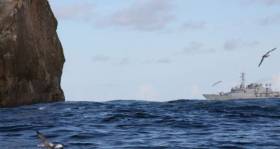Displaying items by tag: Scottish Minister
Clydeside Shipyard Delayed Ferries for CalMac 'to Carry Fewer Passengers than First thought'
The considerably delayed newbuilds for Scotland ferry operator, Caledonian MacBrayne (CalMac) which are being built at Ferguson Marine shipyard, Port Glasgow, will it has emerged carry fewer passengers than first envisioned.
As STV reports, the reduction in passenger capacity of the leadship twins, Glen Sannox and recently named Glen Rosa, is in response to safety certification measures as required by the regulator, the Maritime and Coastguard Agency (MCA).
This will see each ferry with a maximum carrying capacity of 1,000 reduced to 852 passengers, a difference of 148 in the original design of the newbuilds, with the first the Glen Sannox Afloat highlights was due to enter service in 2018.
Chief executive of the Scottish Government-owned shipyard, David Tydeman said the cost of the newbuilds has risen further, see previous coverage.
In a letter sent last week to MSP’s, he said Calmac and the agency Caledonian Maritime Assets Ltd (CMAL) were considering a maximum capacity of 852 passengers to accommodate the required number of stairwells and passageways.
On Tuesday, transport minister Fiona Hyslop said CMAL would only take delivery of the newbuilds, once they had been signed off by the MCA, in addition to the regulator, the class society, which surveys ships.
The minister told the Scottish Parliament that all systems including the Liquid National Gas (LNG) propulsion system will need to be completed, something which will require special pipework.
More here on the ongoing ferry story.
Scottish Minister Blames 'Contractor Failure' for Botched Pair of Ferguson Ferries Order
Scottish Islands minister Paul Wheelhouse told MSPs (yesterday) shipbuilders Ferguson Marine was responsible for the major delays and cost overruns that have plaqued a pair of CalMac Ferries.
He said “contractor failure” had led to the fiasco which will see the ferries (see: Glen Sannox, first of the pair) completed at least four years late and cost twice as much as expected.
Mr Wheelhouse told the Scottish Parliament’s rural economy and connectivity committee: "An independent review of the process has concluded contractor failure has been the cause.”
Ferguson was taken over by ministers last year after it went into administration.
Mr Wheelhouse said the Scottish Government did what it could to ensure the project was finished on time as the relationship between Ferguson Marine and Scottish Government-owned Caledonian Maritime Assets Limited (Cmal), which ordered the ferries for CalMac, broke down.
More from The Scotsman here
'lllegal' Irish Vessels Warns Scottish Minister Could be Boarded as Creed Dismisses Navy Involvement
Irish vessels are fishing “illegally”,writes the journal.ie, in the area around Rockall according to a Scottish Minisiter who said an “enforcement plan” will be put in place unless the ships desist from their activity there.
Speaking to RTÉ’s This Week programme, Scottish Minister for the Rural Economy Fergus Ewing said that this action will see Irish captains asked to cease and desist if they are found fishing in this area. If they refuse, he said further action would be taken “in accordance with the law” which would involve vessels being boarded.
However, speaking to the same programme, Minister for Agriculture Michael Creed said Ireland has never recognised the UK’s claim on Rockall, and that all legal avenues would be explored to allow Irish vessels to continue to fish there unhindered.
For much more click here including the issue of jurisdiction over Rockall which has long been disputed.






























































